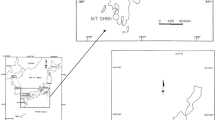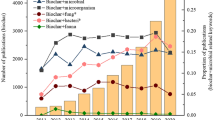Abstract
This paper is based on the results of the study of soils and soil-forming rocks on five key sites in Iceland, including the coastal plain (the Hvammur key site), piedmont plain (the Hveragerði key site), the Holocene lava plateau (the Reykjanes key site), and the zone of modern hydrothermal activity in the north of the rift zone of Iceland (the Theistareykir and Námafjall key sites). The studied soils are subdivided by us into the groups of exothermic and endothermic soils. Exothermic soils are the soils that develop from the congealed volcanic deposits. These soils are specified by the homogeneous dark gray color and sandy texture. Their mineral components are weakly transformed. Exothermic soils developed under good drainage conditions have the low content of organic matter (about 1.5% Corg). The soil reaction is neutral within the entire profile. Under impeded drainage conditions, the organic carbon content in the exothermic soils reaches its maximum of about 7%, and the soil reaction varies from acid to neutral values. Endothermic soils are the soils that are subjected at present or were subjected in the past to the high-temperature hydrothermal metamorphism. They have mottled color patterns with sharp color contrast in the soil profile; their texture is loamy or clayey. These soils are rich in secondary minerals with a predominance of smectite; kaolinite, pyrite, anatase, gypsum, and other secondary minerals can also be found in them. The properties of endothermic soils are largely controlled by the provincial features of the hydrothermal activity, including the chemical composition of hydrothermal water, the soil temperature, the duration of hydrothermal activity, etc.
Similar content being viewed by others
References
V. F. Babanin, V. I. Trukhin, L. O. Karpachevskii, et al., Magnetism of Soils (Yaroslavl, 1995) [in Russian].
A. R. Geptner, Kh. Kristmannsdokhtir, and M. A. Selezneva, “Secondary Basaltic Minerals Modified by Hydrothermal Brine on the Reykjanes Peninsula (Iceland),” Litol. Polezn. Iskop., No. 2, 25–41 (1987).
A. R. Geptner, T. A. Ivanovskaya, and E. V. Pokrovskaya, “Hydrothermally Modified Clay Sediments in the Rift Zone of Iceland (Effect of Microbiota on the Accumulation of Trace Elements),” Litol. Polezn. Iskop., No. 4, 371–384 (2006).
I. P. Gerasimov and O. A. Chichagova, “Subarctic Peaty-Soddy Volcanic Soils of Iceland,” in Genesis and Geography of Foreign Soils Studied by Soviet Geographers: Scientific Papers Devoted to the VIII International Congress of Soil Science in Bucharest, Romania, 1964 (Moscow, 1964), pp. 111–128 [in Russian].
D. S. Orlov and N. M. Grindel’, “Spectrophotometric Determination of Humus in the Soil,” Pochvovedenie, No. 1, 112–122 (1967).
O. Arnalds, “Soils and Soil Erosion in Iceland,” in Geochemistry of the Earth’s Surface: Proceedings of the Fifth International Symposium on the Geochemistry of the Earth’s Surface, Ed. by H. Armannson and A. A. Balkema (Rotterdam, 1999), pp. 135–138.
O. Arnalds, “Soil Survey and Databases in Iceland,” in Soil Resources of Europe, Ed. by P. Bullock, R. J. A. Jones, and L. Montanarella (London, 1999), Vol. 6, pp. 91–96.
O. Arnalds, “The Icelandic ‘Rofabard’ Soil Erosion Features,” Earth Surf. Process. Landforms 25, 17–28 (2000).
O. Arnalds, “Volcanic Soils of Iceland,” Catena 56, 3–20 (2004).
O. Arnalds, C. T. Hallmark, and L. P. Wilding, “Andisols from Four Different Regions of Iceland,” Soil Sci. Soc. Am. J. 58, 161–169 (1995).
O. Arnalds, F. O. Gisladottir, and H. Sigurjonsson, “Sandy Deserts of Iceland: An Overview,” J. Arid Environ. 47, 359–371 (2001).
O. Arnalds and J. Kimble, “Andisols of Deserts in Iceland,” Soil Sci. Soc. Am. J. 65, 1778–1786 (2001).
O. Arnalds, E. F. Thorarinsdottir, S. Metusalemsson, et al., Soil Erosion in Iceland (Reykjavik, 2001).
S. Bjöernsson, S. Arnorsson, and J. Tomasson, “Economic Evaluation of Reykjanes Thermal Brine Area, Iceland,” Bull. Amer. Assoc. Petrol. Geol. 56(12), 2380–2391 (1972).
Soil Map of the World. Revised Legend, Soil Resources Report, No. 60, (FAO, Rome, 1988).
G. Gudbergsson, “Myndun moajardvegs i Skagafirdi (Soil Formation in Skagafjordur, Northern Iceland),” J. Agric. Res. Iceland 7(1–2), 20–45 (1975).
Th. Gudmundsson, PhD Thesis (University of Aberdeen, 1978).
Th. Gudmundsson, “Jardvegsflokkun FAO me? Hlidsjon af inslenskum adstaedum (The FAO Soil Classification System, with Icelandic Adaptation),” RALA Report 167 (1994).
Th. Gudmundsson, H. Björnsson, and G. Thorvaldsson, “Organic Carbon Accumulation and pH Changes in an Andic Gleysol under a Long-Term Fertilizer Experiment in Iceland,” Catena 56, 213–224 (2004).
R. Guicharnaud, B. Sc. Thesis (University of Iceland, Reykjavik, 2002).
B. Helgason, “Basaltic Soils of South-West Iceland,” J. Soil Sci. 14, 64–72 (1963).
B. Helgason, “Basaltic Soils of South-West Iceland,” J. Soil Sci. 19, 127–134 (1968).
B. Johannesson, The Soils of Iceland (Reykjavik Agricultural Research Institute, 1960).
J. Jonsson, “Sandur-Sandar, Nokkrar Athuganir (Sand, Some Observations),” Research Institute Nedri ADs Report 53 (1995).
B. Orradottir, M. Sc. Thesis (Texas, College Station, 2002).
H. Oskarsson, O. Arnalds, J. Gudmundsson, and G. Gudbergsson, “Organic Carbon in Icelandic Andosols: Geographical Variation and Impact of Erosion,” Catena 56, 225–238 (2004).
G. Sigbjarnarson, “Afok og uppblastur (The Loessial Soil Formation and the Soil Erosion on Haukadalsheidi),” Natturufraedingurinn 39 49–128 (1969).
Keys to Soil Taxonomy (USDA-NRCS, Washington, DC, 1998).
I. Strachan, O. Arnalds, F. Palmason, et al., “Soils of the Gunnarsholt Experimental Plantation,” Icel. Agric. Sci. 12, 27–38 (1998).
I. Strachan, B. D. Sigurdsson, and J. H. McCaughey, “Soil Hydrology at the Gunnarsholt Experimental Plantation: Measurements and Results,” Icel. Agric. Sci. 12, 39–46 (1998).
S. Thorarinsson, “Urrblastur a Islandi i ljosi oskulagarannsokna (Wind Erosion in Iceland: A Thermochronological Study),” Icelandic Forestry Society Yearbook, (1961), Vols. 17–54.
Th. E. Thorhallsdottir, “Tundra Ecosystems of Iceland,” in: Polar and Alpine Tundra, Ed. by F. E. Wiegolaski (Elsevier, Amsterdam, 1997), pp 85–96.
Author information
Authors and Affiliations
Additional information
Original Russian Text © A.N. Gennadiev, A.R. Geptner, A.P. Zhidkin, S.S. Chernyanskii, Yu.I. Pikovskii, 2007, published in Pochvovedenie, 2007, No. 6, pp. 661–675.
Rights and permissions
About this article
Cite this article
Gennadiev, A.N., Geptner, A.R., Zhidkin, A.P. et al. Exothermic and endothermic soils of Iceland. Eurasian Soil Sc. 40, 595–607 (2007). https://doi.org/10.1134/S1064229307060014
Received:
Issue Date:
DOI: https://doi.org/10.1134/S1064229307060014




